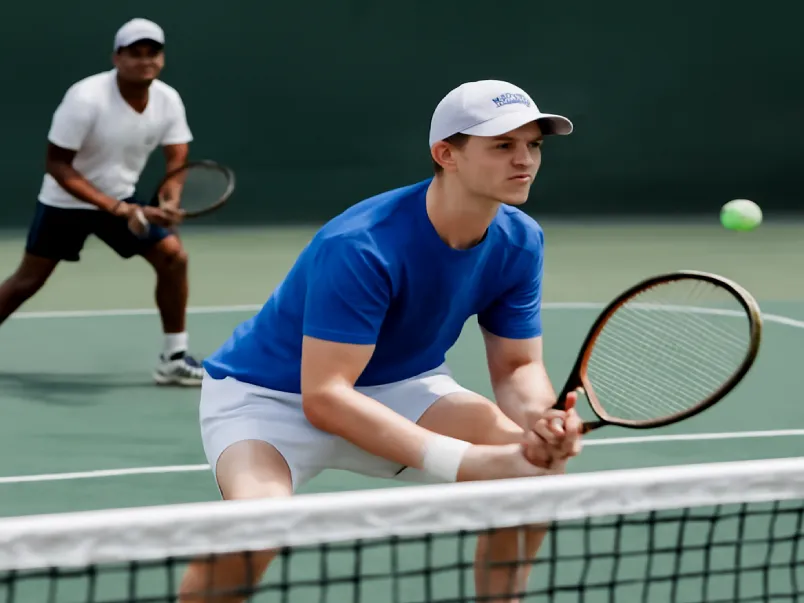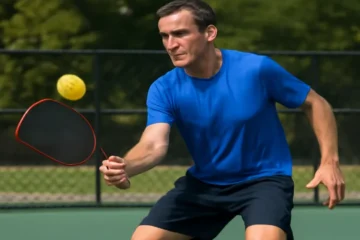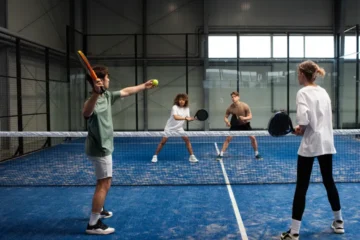In doubles tennis, the team that controls the net often wins the match. This isn’t just a cliché; it’s a fact. Whether you’re playing in a competitive tournament or a friendly match, establishing dominance at the net can make all the difference. The net is the throne room of doubles, a place where points are won quickly, where pressure is applied, and where errors are forced. The team that owns this space has a clear advantage, but how do you become the player that takes control of the net?
In this complete guide, we’ll show you the strategic and tactical blueprint to not just survive at the net but dominate it. From mastering your positioning to understanding when and how to approach, poach, and make that perfect volley, this guide will make you a net force to be reckoned with.
I. Why the Net is the Throne Room of Doubles
The net isn’t just a piece of equipment on the court; it’s the key to asserting your dominance in doubles tennis. Picture this: two players locked in an intense rally, running from side to side, when suddenly one of them steps forward with confidence and claims that coveted net position. This move changes everything.
The team that controls the net dictates the pace and direction of the game. They cut off angles for their opponents, putting immense pressure on their decisions and forcing errors. A well-positioned net player can turn a rally in their favor with a perfectly timed volley, a powerful overhead, or even a well-placed drop volley.
The net isn’t just a strategic position; it’s a psychological weapon. The mere presence of a strong net player can make opponents feel rushed, hurried, and unsure of where to place the ball. This creates an atmosphere where mistakes are inevitable, and the net player capitalizes on those errors to win points.
II. The Foundation: The Pillars of Net Play
A. The Ready Position: Your Athletic Stance for Success
Before you can dominate the net, you need to have the right stance and mindset. The ready position is where everything begins. When you’re at the net, you need to be in an athletic stance that allows for quick reaction and movement.
- Knees Bent: Lower your center of gravity by bending your knees. This position helps you spring into action quickly, whether you need to move left, right, or forward.
- Weight on the Balls of Your Feet: Keeping your weight forward will help you react faster and move with ease.
- Racket Up, Out in Front: Your racket should be positioned in front of you, ready for either a volley or an overhead smash.
- Eyes Focused on the Opponent’s Racket and Ball: Anticipation is key at the net. By focusing on your opponent’s racket, you can predict where the ball is headed and react accordingly.
B. Volley Technique: Precision Over Power
The volley is the most fundamental shot at the net, and mastering it is essential to your success. But remember, it’s not about power; it’s about precision and control.
- The Punch, Not the Swing: Volleys require short, controlled movements. Focus on “punching” the ball with a firm racket, not swinging at it.
- Firm Wrist: A stable wrist is crucial for consistency and accuracy. A loose wrist will result in weak volleys that are easily attacked.
- Volleyball Through the Ball: When you volley, think about “volleying through the ball.” Don’t stop the racket; allow it to move slightly forward through the contact point.
C. Footwork: The Art of the Split-Step and Adjustment
Good footwork is the foundation of effective net play. The split-step is crucial in allowing you to adjust to any ball your opponent hits.
- The Split-Step: This timing technique is non-negotiable. As your opponent hits, you should perform a small hop to prepare for the next shot. The split-step ensures that you’re balanced and ready to move in any direction.
- Small, Quick Adjustment Steps: At the net, your feet must be quick and responsive. As the ball approaches, make small adjustments to get your body behind the ball, ensuring you’re in the best position to make the shot.
III. The Pathway to the Net: How to Get There Safely
You can’t just rush the net on any shot. There’s a clear path and strategy for safely getting to the net and avoiding being caught out of position.
The Golden Rule: Never Come in on a Weak Shot
The golden rule of net play is simple: Never approach the net if your shot isn’t going to put your opponent under pressure. If you approach on a weak shot, your opponents will easily pick you apart.
Key Opportunities to Approach the Net:
- After a Deep, Forcing Return of Serve: A deep return of serve, especially if it pushes your opponent back, gives you the opportunity to move to the net and pressure your opponent immediately.
- After a Well-Placed, Penetrating Approach Shot: Hitting an approach shot down the middle, or to your opponent’s weaker side, can set you up perfectly for the net.
- Behind a Strong, Dipping Shot at the Net Player’s Feet: A shot that lands at your opponent’s feet is almost impossible to return effectively. Follow up by charging to the net.
- The I-Formation on Serve: This formation can confuse your opponents and set up opportunities for your partner to poach. By disguising your serve, you can create an opening for a quick transition to the net.
IV. Net Positioning: Where to Stand for Maximum Impact
Your positioning at the net is crucial. Stand too far back, and you’ll leave gaps for your opponents to exploit. Stand too close, and you might be caught off guard by a lob or an unexpected shot.
The Ideal Position: 3-5 Feet from the Net
Ideally, you want to be positioned about 3-5 feet from the net, just inside the service line. This area allows you to cover most angles while still being able to move quickly.
Lateral Movement: The “See-Saw” Effect
You and your partner should move as a team at the net. If one of you is pulled wide, the other should shift to cover the middle. This synchronized movement ensures that you are always in a position to control the court.
Controlling the “Alley-Middle-Alley” Zones
Your coverage responsibilities depend on where the ball is. If the ball is hit down the sideline, cover the alley. If it’s toward the middle, both players need to shift to cover the center of the court.
V. Winning as a Team: Communication and Court Geometry
In doubles, communication is everything. Without it, even the best players will struggle to control the net.
A. Communication is Key
- Pre-Point Planning: Before every point, communicate with your partner. Agree on strategies like “I’m poaching on the second serve” or “You go for the lob.”
- During the Point: Call out “MINE!” or “YOURS!” when you’re about to intercept a shot. This reduces confusion and allows both players to stay on the same page.
- Hand Signals: Use hand signals behind the back to communicate tactics like a fake poach or down-the-line shot.
B. The Strategic Use of the Poach
Poaching is when you cross the centerline to intercept a ball meant for your partner. It’s a bold and aggressive move that can catch your opponents off guard.
- When to Poach: Poaching works best when your opponent is predictable in their shot placement. A cross-court rally ball or return is an ideal opportunity.
- The Fake Poach: You don’t always need to make contact with the ball. Sometimes, just faking a poach can force your opponents to hit a bad shot or make an error.
C. Targeting the Middle
Targeting the middle of the court is one of the most effective ways to confuse your opponents. It creates doubt in their minds about who should take the shot, often resulting in missed opportunities.
VI. Shot Selection: Your Arsenal for Net Domination
At the net, you have a variety of shots to choose from. The key is knowing when to use each one.
The Volley:
- The Block Volley: Used for fast-paced shots. Don’t try to add power—just block the ball back.
- The Punch Volley: For medium-speed shots, punch the ball into the open court, focusing on placement rather than power.
The Overhead Smash:
- Positioning: Get under the ball and use your legs to generate power for a smash.
- Power vs. Placement: If you’re close to the net, placement is key. If you’re further back, go for power.
The Drop Volley:
A surprise shot, used against opponents who are deep in the court. It’s a delicate shot that can completely throw off your opponents’ rhythm.
The Angle Volley:
A sharp-angle volley can finish a point quickly when you have an open court. Make sure your body is positioned correctly for maximum control.
VII. Drills to Become a Net Monster
To master the net, you need to practice specific drills that will improve your reflexes, positioning, and decision-making.
1. Volley-to-Volley Drill:
This drill focuses on improving your reaction time and volley technique. Practice quick volleys with a partner, working on your form and movement.
2. The “Two-on-One” Drill:
In this drill, one player starts at the baseline while two players are at the net. The net players work on intercepting and controlling the ball against a baseliner.
3. Poaching Drill:
This drill focuses on improving your poaching technique. The net player practices crossing the centerline to intercept a ball.
4. Overhead Practice:
Lob-smash drills will help you improve your overhead technique. Practice getting under the ball and making consistent, powerful smashes.
VIII. Common Mistakes and How to Fix Them
Even the best players make mistakes. Here are some common net play mistakes and how to fix them.
Mistake 1: Standing Still After the Split-Step
Fix: Keep your feet active and ready to move quickly after the split-step.
Mistake 2: Swinging at Volleys
Fix: Focus on the punch volley, keeping your motions compact.
Mistake 3: “Ball Watching”
Fix: Always keep your eyes on the opponent, not just the ball.
Mistake 4: Poor Communication
Fix: Develop a habit of communicating with your partner before and during every point.
IX. Conclusion: Claim Your Throne
Mastering the net isn’t just about technique; it’s about attitude. By implementing these strategies, techniques, and drills, you’ll transform yourself into a net-dominating force on the court. Communication, positioning, and aggression are the keys to owning the net. Be bold, take control, and claim your throne at the net. After all, it’s not just a position on the court—it’s a state of mind.
Go dominate the net!
FAQs:
1. Why is the net so important in doubles tennis?
The net is a critical area in doubles tennis because it allows you to control the pace of the game, force errors, and set up easy put-aways. By dominating the net, you can put immense pressure on your opponents and increase your chances of winning points.
2. How do I approach the net effectively in doubles?
To approach the net effectively, make sure you’re not rushing in on a weak shot. Look for opportunities such as a deep return of serve, a well-placed approach shot, or a strong shot aimed at your opponent’s feet. Using an “I-formation” serve can also confuse opponents and set you up for a quick transition to the net.
3. What is poaching in doubles tennis?
Poaching refers to crossing over the centerline of the court to intercept a ball intended for your partner. It’s an aggressive tactic to gain control of the point. Poaching works best when your opponent’s shot is predictable, and it can also involve deceptive moves like fake poaching to force an error.
4. What are the best volley techniques for controlling the net?
Master the “punch” volley technique, where you use short, controlled movements rather than swinging at the ball. Focus on firm wrist positioning to maintain control. A block volley is ideal for fast shots, while a punch volley works well for medium-paced balls.
5. How can I improve my net play in doubles?
To improve your net play, practice drills like volley-to-volley exercises, poaching drills, and overhead smash practice. Ensure that your footwork is sharp, use the split-step to prepare for movement, and communicate clearly with your partner during every point.
6. What are common mistakes at the net in doubles tennis?
Common mistakes include standing still after the split-step, swinging at volleys instead of punching them, ball-watching, and poor communication with your partner. These can be fixed by staying active on your feet, practicing compact volley techniques, keeping your eyes on the opponent, and ensuring clear communication before and during each point.
7. How should I position myself at the net in doubles?
Your ideal net position should be about 3-5 feet from the net, just inside the service line. This allows you to cover angles while still being quick enough to adjust. Additionally, ensure that you and your partner move together, with both of you covering the “middle” and “alley” zones when necessary.




